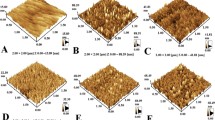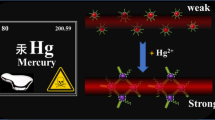Abstract
Cu2+ is a bio-accumulative and toxic environmental pollutant, so its sensitive and selective detection is of great importance. In this work, gold nanoparticles were electrochemically deposited on fluorine-doped tin oxide and characterized by scanning electron microscope and cyclic voltammetry. 4-Mercaptobenzoic acid (4-MBA), which contained carboxyl chelator, was self-assembled on the surface of gold nanoparticles through S–Au bond. The strong chelation of Cu2+ with 4-MBA formed a stable Cu2+-4-MBA complex, which was confirmed by energy-dispersive X-ray spectroscopy. Square wave voltammetry was applied to determine the concentration of Cu2+. Under optimized condition, the oxidation peak current was proportional to the concentration of Cu2+ in the range of 10–1500 nM with limit detection of 8 nM. The proposed electrochemical sensor showed excellent selectivity towards Cu2+. In addition,the applicability of the developed sensor was evaluated by determining the concentrations of Cu2+ in river water samples, which were consistent with the results of inductively coupled plasma mass spectroscopy.








Similar content being viewed by others
References
Que EL, Domaille DW, Chang CJ. Metals in neurobiology: probing their chemistry and biology with molecular imaging. Chem Rev. 2008;108:1517–49.
Emerit J, Edeas M, Bricaire F. Neurodegenerative diseases and oxidative stress. Biomed Pharmacother. 2004;58:39–46.
Fisher AE, Naughton DP. Therapeutic chelators for the twenty first century: new treatments for iron and copper mediated inflammatory and neurological disorders. Curr Drug Deliv. 2005;2:261–8.
Becker JS, Matusch A, Depboylu C, Dobrowolska J, Zoriy MV. Quantitative imaging of selenium, copper, and zinc in thin sections of biological tissues (slugs−genus arion) measured by laser ablation inductively coupled plasma mass spectrometry. Anal Chem. 2007;79:6074–80.
Adeleye AS, Oranu EA, Tao M, Keller AA. Release and detection of nanosized copper from a commercial antifouling paint. Water Res. 2016;102:374–82.
Navratilova J, Praetorius A, Gondikas A, Fabienke W, Kammer FVD, Hofmann T. Detection of engineered copper nanoparticles in soil using single particle ICP-MS. Int J Env Res Pub Health. 2015;12:15756–68.
Yakubenko EV, Voitkova ZA, Chernikova II, Ermolaeva TN. Microwave sample preparation for detection of Si, P, V, Cr, Mn, Ni, Cu, and W using inductively coupled plasma atomic emission spectrometry in engineering steels. Inorg Mater. 2015;51:1370–4.
Wang X, Zhang C, Zhang Y, Sun J, Cao L, Ji J, Feng F. Facile crosslinking of polythiophenes by polyethylenimine via ester aminolysis for selective Cu(II) detection in water. Biosens Bioelectron. 2018;109:255–62.
Yuan Z, Cai N, Du Y, He Y, Yeung ES. Sensitive and selective detection of copper ions with highly stable polyethyleneimine-protected silver nanoclusters. Anal Chem. 2014;86:419–26.
Cho SW, Rao AS, Bhunia S, Reo YJ, Singha S, Ahn KH. Ratiometric fluorescence detection of Cu(II) with a keto-dipicolylamine ligand: a mechanistic implication. Sens Actuators B. 2019;279:204–12.
Li C, Ouyang H, Tang X, Wen G, Liang A, Jiang Z. A surface enhanced Raman scattering quantitative analytical platform for detection of trace Cu coupled the catalytic reaction and gold nanoparticle aggregation with label-free victoria blue B molecular probe. Biosens Bioelectron. 2017;87:888–93.
Sarkar S, Pradhan M, Sinha AK, Basu M, Pal T. Selective and sensitive recognition of Cu2+ in an aqueous medium: a surface-enhanced Raman scattering (SERS)-based analysis with a low-cost Raman reporter. Chem- Eur J. 2012;18:6335–42.
Li H, Bai H, Lv Q, Wang W, Wang Z, Wei H, Zhang Q. A new colorimetric sensor for visible detection of Cu(II) based on photoreductive ability of quantum dots. Anal Chim Acta. 2018;1021:140–6.
Hu Y, Zhang J, Lv YZ, Huang XH, Hu SL. A new rhodamine-based colorimetric chemosensor for naked-eye detection of Cu2+ in aqueous solution. Spectrochim Acta A. 2016;159:164–9.
Xu J, Li Z, Yue X, Xie F, Xiong S. The electrochemical detection of Cu(II) using amino functionalized MgFe2O4/reduced graphene oxide composite. Anal Methods. 2018;10:2026–33.
Wang N, Dai H, Wang D, Ma H, Lin M. Determination of copper ions using a phytic acid/polypyrrole nanowires modified glassy carbon electrode. Mater Sci Eng, C. 2017;76:139–43.
Zuo Y, Xu J, Jiang F, Duan X, Lu L, Guo Y, Li C, Yu Y. Utilization of AuNPs dotted S-doped carbon nanoflakes as electrochemical sensing platform for simultaneous determination of Cu (II) and Hg(II). J Electroanal Chem. 2017;794:71–7.
Sha H, Wu Y, Fan Y. A Fe-OSA/Nafion composite film-decorated glassy carbon electrode as a sensor for detection of Pb(II), Cd(II) and Cu(II). Anal Methods. 2017;9:5618–31.
Zamhari M, Numnuam A, Limbut W, Kanatharana P, Thavarungkul P. Simultaneous electrochemical detection of Co(II) and Cu(II) by 1-diazo-2-naphthol-4-sulfonic acid/MWCNTs modified electrode. Electroanal. 2017;29:2348–57.
Allara DL, Hebard AF, Padden FJ, Nuzzo RG, Falcone DR. Chemically induced enhancement of nucleation in noble metal deposition. J Vac Sci Technol, A. 1983;1:376–82.
Sushko ML, Shluger AL. Dipole-dipole interactions and the structure of self-assembled monolayers. J Phys Chem B. 2007;111:4019–25.
Yantasee W, Warner CL, Sangvanich T. Removal of heavy metals from aqueous systems with thiol functionalized superparamagnetic nanoparticles. Environ Sci Technol. 2007;41:5114–9.
Luna DMN, Avelino KYPS, Cordeiro MT, Andrade CAS, Oliveira MDL. Electrochemical immunosensor for dengue virus serotypes based on 4-mercaptobenzoic acid modified gold nanoparticles on self-assembled cysteine monolayers. Sens Actuators B. 2015;220:565–72.
Zhang Q, Lu X, Ping T, Zhang D, Tian J, Zhong L. Gold nanoparticle (AuNP)-based surface-enhanced Raman scattering (SERS) probe of leukemic lymphocytes. Plasmonics. 2016;11:1361–8.
Chen J, Huang Y, Yang X, Zhang H, Li Z, Qin B, Chen X, Qiu H. Highly sensitive and visual detection of guanosine 3′-diphosphate-5′-di(tri)phosphate (ppGpp) in bacteria based on copper ions-mediated 4-mercaptobenzoic acid modified gold nanoparticles. Anal Chim Acta. 2018;1023:89–95.
Zamborini FP, Leopold MC, Hicks JF, Kulesza PJ, Malik MA, Murray RW. Electron hopping conductivity and vapor sensing properties of flexible network polymer films of metal nanoparticles. J Am Chem Soc. 2002;124:8958–64.
Tan BJ, Sow CH, Koh TS, Chin KC, Wee AT, Ong CK. Fabrication of size-tunable gold nanoparticles array with nanosphere lithography, reactive ion etching, and thermal annealing. J Phys Chem B. 2005;109:11100–9.
Li M, Gao H, Wang X, Wang Y, Qi H, Zhang C. A fluorine-doped tin oxide electrode modified with gold nanoparticles for electrochemiluminescent determination of hydrogen peroxide released by living cells. Microchim Acta. 2016;184:603–10.
Barriet D, Yam CM, Shmakova OE, Jamison AC, Lee TR. 4-Mercaptophenylboronic acid SAMs on gold: comparison with SAMs derived from thiophenol, 4-mercaptophenol, and 4-mercaptobenzoic acid. Langmuir. 2007;23:8866–75.
Pensa E, Rubert AA, Benitez G, Carro P, Orive AG, Creus AH, Salvarezza RC, Vericat C. Are 4-mercaptobenzoic acid self assembled monolayers on Au(111) a suitable system to test adatom models. J Phys Chem C. 2012;116:25765–71.
Yang X, Jia Z, Cheng X, Luo N, Choi MMF. Synthesis of N-acetyl-l-cysteine capped Mn:doped CdS quantum dots for quantitative detection of copper ions. Spectrochim Acta A. 2018;199:455–61.
Wu X, Wang H, Yang S, Tian H, Liu Y, Sun B. A novel coumarin-based fluorescent probe for sensitive detection of copper(II) in wine. Food Chem. 2019;284:23–7.
Boonmee C, Noipa T, Tuntulani T, Ngeontae W. Cysteamine capped CdS quantum dots as a fluorescence sensor for the determination of copper ion exploiting fluorescence enhancement and long-wave spectral shifts. Spectrochim Acta A. 2016;169:161–8.
Fan C, Luo S, Rong L. Optimization of an analytical method for the spectrophotometric determination of copper in tea and water samples after ultrasonic assisted cloud point extraction using a benzothiazole fluorescein derivative complexing agent. RSC Adv. 2015;5:65321–7.
Özzeybek G, Erarpat S, Chormey DS, Fırat M, Büyükpınar Ç, Turak F, Bakırdere S. Sensitive determination of copper in water samples using dispersive liquid-liquid microextraction-slotted quartz tube-flame atomic absorption spectrometry. Microchem J. 2017;132:406–10.
Amjadi M, Manzoori JL, Hallaj T, Azizi N. Sulfur and nitrogen co-doped carbon dots as the chemiluminescence probe for detection of Cu2+ ions. J Lumin. 2017;182:246–51.
Ma Z, Wu T, Xu T. Sensitive electrochemical detection of copper ions based on the copper (II) ion assisted etching of Au@Ag nanoparticles. Analyst. 2015;140:8041–7.
Frag EY, Abdel Hameed RM. Preparation, characterization and electrochemical application of CuNiO nanoparticles supported on graphite for potentiometric determination of copper ions in spiked water samples. Microchem J. 2019;144:110–6.
Acknowledgements
This research is supported by the National Natural Science Foundation of China (Nos. 61571278, 61571280).
Author information
Authors and Affiliations
Corresponding authors
Electronic supplementary material
Below is the link to the electronic supplementary material.
About this article
Cite this article
Zhou, M., Han, L., He, H. et al. Sensitive and Selective Determination of Cu2+ Using Self-Assembly of 4-Mercaptobenzoic Acid on Gold Nanoparticles. J. Anal. Test. 3, 306–312 (2019). https://doi.org/10.1007/s41664-019-00102-2
Received:
Accepted:
Published:
Issue Date:
DOI: https://doi.org/10.1007/s41664-019-00102-2




